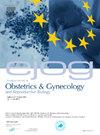慢性盆腔疼痛患者的抑郁和焦虑患病率:一项系统回顾和荟萃分析。
IF 2.1
4区 医学
Q2 OBSTETRICS & GYNECOLOGY
European journal of obstetrics, gynecology, and reproductive biology
Pub Date : 2025-02-01
DOI:10.1016/j.ejogrb.2024.12.042
引用次数: 0
摘要
目的:本研究旨在了解慢性盆腔疼痛(CPP)女性抑郁和焦虑的患病率及其相关因素。方法:使用PubMed、Embase和SciELO平台进行系统评价和荟萃分析,重点关注2010年至2024年间发表的研究。结果:对8项研究进行了评估,并证明了焦虑和抑郁在CPP女性中的显著患病率,分别为22.8%至79.0%和14.0%至56.9%。HADS(医院焦虑和抑郁量表)是筛查焦虑和抑郁最常用的工具(37.5%),PHQ(患者健康问卷)使用了25.0%,一项研究使用了DSM-IV(精神障碍诊断和统计手册),另一项研究依赖于这些障碍的自我报告。在荟萃分析中,发现CPP患者患焦虑症的可能性是其他患者的两倍,而不是抑郁症。这些研究的医疗背景各不相同,只有两项研究特别关注于评估CPP女性的精神障碍。结论:CPP患者焦虑患病率增加,抑郁患病率升高,但无统计学意义。与身体和性虐待、早期情感创伤、子宫内膜异位症和手术创伤有显著关联。本文章由计算机程序翻译,如有差异,请以英文原文为准。
Prevalence of depression and anxiety in women with chronic pelvic Pain: A systematic review and Meta-Analysis
Purpose: This study aimed to present the prevalence of depression and anxiety in women with Chronic Pelvic Pain (CPP) and their associated factors. Methods: This systematic review and meta-analysis were conducted using the PubMed, Embase, and SciELO platforms, focusing on studies published between 2010 and 2024. Results: Eight studies were evaluated and demonstrated a significant prevalence of anxiety and depression in women with CPP, ranging from 22.8% to 79.0% and 14.0% to 56.9%, respectively. The HADS (Hospital Anxiety and Depression Scale) was the most used tool for screening anxiety and depression (37.5%), the PHQ (Patient Health Questionnaire) was used by 25.0%, one study used the DSM-IV (Diagnostic and Statistical Manual of Mental Disorders), and another relied on self-reporting of these disorders. In the meta-analysis, patients with CPP were found to be twice as likely to have anxiety disorders but not depression. The studies varied in their healthcare context, and only two specifically focused on evaluating mental disorders in women with CPP. Conclusion: An increased prevalence of anxiety was observed in women with CPP, while the prevalence of depression was elevated but not statistically significant. Significant associations were found with physical and sexual abuse, early emotional trauma, endometriosis, and surgical trauma.
求助全文
通过发布文献求助,成功后即可免费获取论文全文。
去求助
来源期刊
CiteScore
4.60
自引率
3.80%
发文量
898
审稿时长
8.3 weeks
期刊介绍:
The European Journal of Obstetrics & Gynecology and Reproductive Biology is the leading general clinical journal covering the continent. It publishes peer reviewed original research articles, as well as a wide range of news, book reviews, biographical, historical and educational articles and a lively correspondence section. Fields covered include obstetrics, prenatal diagnosis, maternal-fetal medicine, perinatology, general gynecology, gynecologic oncology, uro-gynecology, reproductive medicine, infertility, reproductive endocrinology, sexual medicine and reproductive ethics. The European Journal of Obstetrics & Gynecology and Reproductive Biology provides a forum for scientific and clinical professional communication in obstetrics and gynecology throughout Europe and the world.

 求助内容:
求助内容: 应助结果提醒方式:
应助结果提醒方式:


